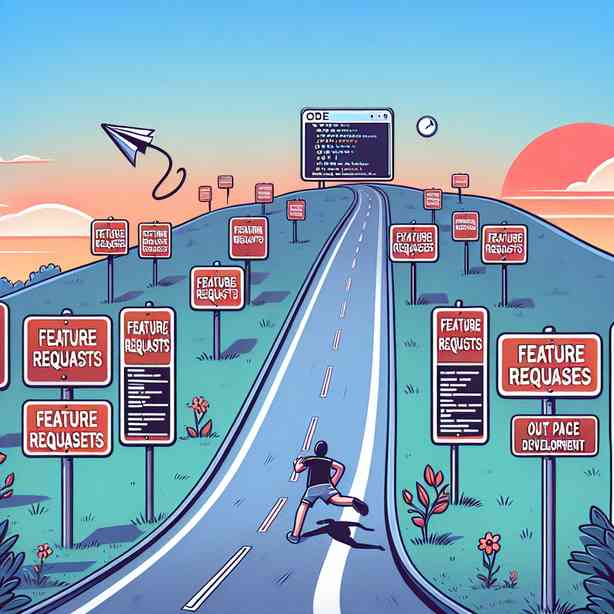
When feature requests outpace development, it can lead to a multitude of challenges for product teams and organizations. As businesses strive to remain competitive and aligned with customer expectations, they often receive an influx of requests for new features, updates, and enhancements. While this feedback is invaluable, it can create a scenario where the demand for new functionalities far exceeds the capacity of development teams to deliver them. It’s essential to navigate this delicate balance to ensure that the organization remains agile, innovative, and responsive to user needs.
Firstly, let’s explore why feature requests are on the rise. Today’s consumers are more vocal about their needs and preferences than ever before, largely due to the increasing accessibility of communication channels. Social media, user forums, and direct feedback mechanisms enable customers to articulate their desires directly to companies, resulting in a flood of suggestions. Additionally, as technology evolves rapidly, users come to expect continuous improvement and new functionalities from the products they use. This creates a scenario where product teams are bombarded with requests, making it challenging to prioritize and execute development effectively.
When the volume of requests grows beyond what the development team can manage, several issues can arise. One of the primary challenges is the risk of burnout among team members. Developers who face an ever-increasing backlog may feel overwhelmed, leading to decreased morale and productivity. This burnout can also affect the quality of the work produced, as stressed developers may be unable to devote the necessary attention and creativity to their tasks, ultimately resulting in features that do not meet user expectations.
Another significant issue is the potential for missed deadlines and compromised project timelines. When feature requests constantly outpace development capabilities, teams may struggle to stay on schedule. This can lead to rushed implementations and half-baked features that are released to meet demands but fail to satisfy users fully. In turn, this can lead to a negative feedback loop where dissatisfied customers generate even more requests and criticism.
To address these challenges effectively, organizations must implement a strategic approach to handling feature requests. One solution is to prioritize requests based on a well-defined set of criteria. Factors such as user impact, alignment with product vision, and technical feasibility should be considered when evaluating which requests to tackle first. By prioritizing requests systematically, teams can focus their efforts on high-impact features that drive the most value for customers and the business.
Furthermore, fostering communication between product management, development teams, and customers is crucial. Regular updates and transparency can help manage expectations and foster trust. By informing users about the status of their requests, teams can mitigate frustration and demonstrate that they value customer feedback. This open line of communication also allows organizations to gather additional insights; sometimes, a feature request may unveil underlying problems or desires that can lead to even better solutions.
Another aspect to consider is resource allocation. As teams frequently face the dilemma of competing priorities, effective resource management becomes critical. Organizations may need to assess whether more developers are needed, if training can enhance existing capabilities, or if other strategies can be employed to maximize efficiency. In some cases, taking a step back to evaluate the team’s structure and processes can reveal areas for improvement, leading to more streamlined workflows and an enhanced ability to address feature requests.
Investing in technology that aids development processes can also be beneficial. Tools for project management, collaboration, and analytics can provide teams with the insights they need to manage feature requests better. By harnessing data to understand usage patterns and customer behavior, teams can make informed decisions about where to focus their development efforts.
As teams implement these strategies, they should remain mindful of the importance of innovation. While managing feature requests is fundamentally essential, fostering an environment that encourages creative thinking and experimentation is equally vital. Allowing time for exploration and development of new ideas can lead to breakthrough enhancements that significantly boost user satisfaction.
Moreover, organizations should consider the possibility of involving users in the development process. Techniques such as beta testing, user groups, and co-creation can provide direct insights into user needs and preferences while also fostering greater engagement. By involving customers, companies can level-set expectations and ensure that the final product closely aligns with what users truly want.
In conclusion, when feature requests outpace development, organizations face a complex challenge that necessitates strategic planning, resource management, and innovative thinking. By prioritizing effectively, enhancing communication, optimizing resources, and fostering a culture of innovation, companies can navigate this landscape successfully. While the influx of requests may seem daunting, it also presents an opportunity to deepen customer relationships, drive product improvement, and ultimately create solutions that resonate with users. By understanding the balance between user needs and development capacity, organizations can position themselves for long-term success in an ever-evolving market.


